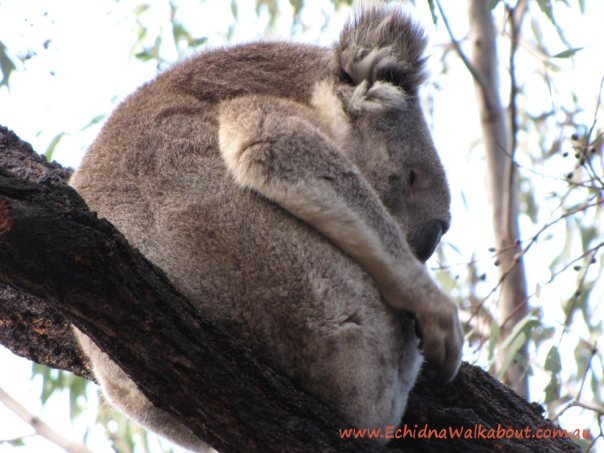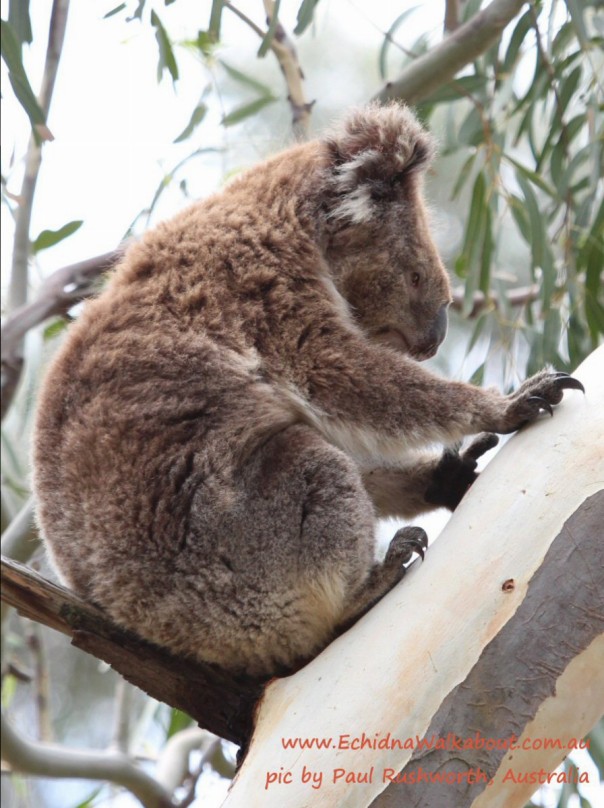Koalas are up there with Polar Bears in many ways… they are a tourism drawcard, a flagship species for conservation, and they both carry a furry pelt that is highly insulating! Wow. Who would think the forests of south-eastern Australia as demanding as the Arctic Icecap? Well, maybe. The Arctic is on the cold side, Australia is on the hot side.
The koala is known to have the highest insulating fur of any marsupial. The fur also provides excellent insulation against wind.(1) Why? It may be due to the fact that the single species of koala lives from the tropical forests of north Queensland, through to the snow-affected alpine ranges of southern Victoria. Koalas in the You Yangs, Victoria experience temperatures of 37C regularly during summer, and minimum winter temperatures of 5 C. The famous ‘cool changes’ of a Victorian summer can drop the temperature by 20 degrees in just 20 minutes. In other parts of their range they experience a temperature range from over 40C in summer to -5C in winter. That’s a 45 degree range of temperature over the year.

Polar Bears also have high fur-insulation, for obvious reasons. They regularly experience temperatures of -40 C, but they don’t like warm temperatures – they start to overheat if the temperature climbs to 10 C. Arctic winters range from -40 to 0C, and summers from -10 to 10C. So, like koalas, they can experience a 45-50 degree range in temperature over the year.
Dawson, Webster & Maloney (2) have shown that koalas and Polar Bears have high and comparable levels of fur insulation.
But many other mammals also experience these temperature ranges, and some, like kangaroos, experience even greater ranges. So why is kangaroo fur not as insulating as koala? The reason has to do with their metabolism and behaviour. Faced with heat, a kangaroo moves away from it – sheltering under a shady bush for the hot part of every day. Kangaroos can do this – they are active animals that can change their environment rapidly. Koalas can not. The limitations of their eucalyptus food source, which is low in nutritional value, has governed their lifestyle and metabolism. They are not able to move a lot, long distances, like kangaroos can. Their low metabolism forces them to stay in a relatively small area, preferably in a tree where they are safe.

Being in a tree has its disadvantages. Solar radiation is high up there. Wind is stronger at height than on the ground. So the koalas that had highly insulated fur were more successful than the ones who didn’t. They’ve evolved to cope well with extremes, by just sitting it out in a gum-tree.
Amazing little battlers, aren’t they?
Read how koala fur protects baby honeyeater birds here.
..
NOTES & REFERENCES:
(1) Robert Degabriele & T. J. Dawson (1979). Metabolism and Heat Balance in an Arboreal Marsupial, the Koala. In Journal of Comparative Physiology 134, 1979, pp 293-301
(2) Terence J Dawson, Koa N Webster, Shane K Maloney (2014) The fur of mammals in exposed environments; do crypsis and thermal needs necessarily conflict? The polar bear and marsupial koala compared. In Journal of Comparative Physiology 184, 2014, pp 273-284
Really nice little story, thanks!
Our pleasure, thanks for sharing it!
Both Polar Bears and Marsupials also give birth (prematurely) to young that aren’t fully developed. While the Polar Bear lacks the marsupials’ carrying pouch, it doesn’t travel for a few months after giving birth (sheltering from the Arctic winter in a snow den) but, otherwise, there are similarities in the outside-of-the-womb early development.
Great information, thanks Rick!